Search results for: 'Art'
-
 Italic fibula with nice incised decoration
Italic fibula with nice incised decorationLarge bronze brooch of a typical boat-shape from Iron Age Italy. A special feature and rarity are the three links of a chain still hanging on the pin.
Price: on request Mesopotamian stamp seal in bull shape
Mesopotamian stamp seal in bull shapeThe magnificent seal is from the Jemdet Nasr period. The stamp shows quadrupeds and a scorpion. Published in a book about the Epstein collection.
Price: on request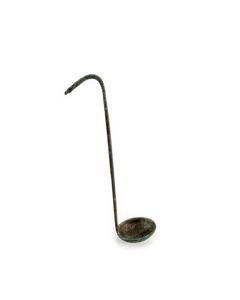 Ancient ladle with donkey head terminal
Ancient ladle with donkey head terminalElegant long bronze ladle, from the Greek or Etruscan culture. 5th to 4th century BC.
Price: on request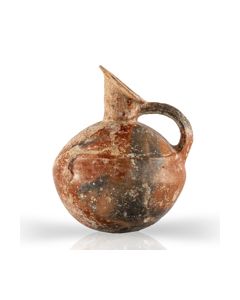 Spouted jug of the Yortan culture
Spouted jug of the Yortan cultureThe large jug has a spherical body, decorated with two stylized arms and hands. From Bronze Age Anatolia.
Price: on request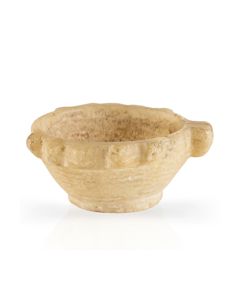 Egyptian alabaster bowl from Luxor
Egyptian alabaster bowl from LuxorThe small stone vessel is an offering bowl for libation. From the collection of Egyptologist Professor Wiedemann. 12th to 18th dynasty of Ancient Egypt
Price: on request Slender Egyptian stone beaker
Slender Egyptian stone beakerThe small and tall stone vessel is made of alabaster. From the collection of Egyptologist Professor Wiedemann.
Price: on request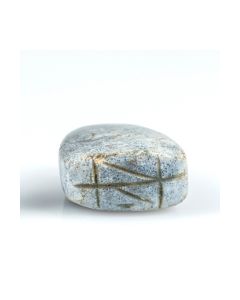 Near Eastern conoid stamp seal
Near Eastern conoid stamp sealColourful seal with geometrical decoration. Neo-Babylonian or Achaemenid, 6th to 5th cent. BC.
Price: on request Roman globular bottle
Roman globular bottlePerfectly preserved glass vessel with globular body. Made in the Eastern Mediterranean during late Roman Imperial times.
Price: on request Conoid stamp seal with spade of Marduk
Conoid stamp seal with spade of MardukThe stamp shows the spade of Marduk, patron deity of the city of Babylon. Above a crescent, symbolizing the moon god Sin. 7th to 6th century BC.
Price: on request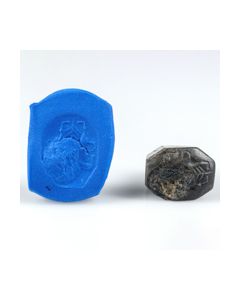 Neo-Assyrian stamp seal
Neo-Assyrian stamp sealThe octagonal seal shows two hybrid creature around a tree of life. It originates from the Neo-Assyrian culture of the 8th to 7th cent. BC.
Price: on request Cone-shaped stamp seal with star of Ishtar
Cone-shaped stamp seal with star of IshtarThe seal depicts a tree of life with a rhomb and eight-pointed star, symbol of Ishtar. 7th to 6th century BC.
Price: on request Gourd shaped bowl of the Chimú culture
Gourd shaped bowl of the Chimú cultureElegant bowl with shiny black surface. Precolumbian pottery of the 10th to 15th century.
Price: on request Henkelkrug aus der Mittleren Bronzezeit
Henkelkrug aus der Mittleren BronzezeitTypische Keramik für den Nahen Osten, die Form weist Parallelen zur sogennanten Tell el-Yahudiyeh Keramik auf. Etwa 2000 v. Chr. bis 1550 v. Chr. Exzellent erhalten.
Price: on request Luristan bronze dagger with tang
Luristan bronze dagger with tangDouble-edged blade of a short dagger from the Luristan region in Ancient Iran. An early type from the Middle Bronze Age.
Price: on request Red-figure Apulian lekythos
Red-figure Apulian lekythosVery good condition, intact and not restored. From an old German private collection, acquired before 1982.
Price: on request Very large red figure neck amphora with thermoluminescence analysis
Very large red figure neck amphora with thermoluminescence analysisAbsolutely exceptional condition for a vase of this size (46cm), worth the exhibition in a museum. Original painting mainly preserved. From an old German collection, acquired prior to 1983 from the antiquities dealer Helmut Liebert, Krefeld, Germany.
Price: on request Egyptian button seal
Egyptian button sealAmulet seal with spirals and blossoms design on the underside. Second Intermediate Period of ancient Egypt.
Price: on request Jama-Coaque roller stamp
Jama-Coaque roller stampClay roller stamp with rich ornamental relief to apply skin decoration. This tool was used in the early phase of the ecuadorian Jama-Coaque culture.
Price: on request Egyptian cowroid
Egyptian cowroidAmulet seal with pseudo hieroglyphs at the underside. Second Intermediate Period of ancient Egypt.
Price: on request Egyptian cowroid with knot design
Egyptian cowroid with knot designAmulet seal with interesting design at the underside that might represent the unity of Egypt. Second Intermediate Period of ancient Egypt.
Price: on request Egyptian cowroid with pseudo hieroglyphs
Egyptian cowroid with pseudo hieroglyphsAmulet seal with papyrus trees and other signs on the bottom side. Second Intermediate Period of ancient Egypt.
Price: on request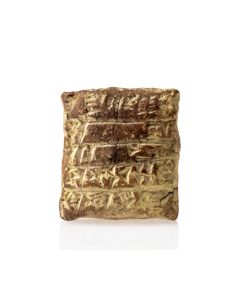 Sumerian cuneiform tablet
Sumerian cuneiform tabletThe clay tablet is a receipt of sheep and goats from the Sumerian city of Puzrish-Dagan. It was made during the reign of King Shu-Sin, 2037 to 2029 BC. From the Yale University Collection.
Price: on request Egyptian green stone vessel
Egyptian green stone vesselThe stone vessel is made of beautiful green serpentine. From the collection of Egyptologist Professor Wiedemann. Middle Kingdom of Ancient Egypt.
Price: on request Egyptian amulet of Bes
Egyptian amulet of BesProtective amulet of the dwarf god Bes made of turquoise faience. Great specimen from Ptolemaic or Roman Egypt.
Price: on request Egyptian amulet of Bes
Egyptian amulet of BesProtective amulet of the dwarf god Bes made of turquoise faience. Great specimen from Ptolemaic or Roman Egypt.
Price: on request Egyptian amulet of Bes
Egyptian amulet of BesProtective amulet with dwarf god Bes in the round. Detailed design. Great specimen from Ancient Egypt.
Price: on request Egyptian chalice
Egyptian chaliceThe thin-walled stone cup is reminiscent of a lotus bud. From the collection of Egyptologist Professor Wiedemann. 18th dynasty of Ancient Egypt.
Price: on request Egyptian stone beaker
Egyptian stone beakerThe elegant stone vase was probably used as an ointment vessel. 5th to 6th dynasty of ancient Egypt, Old Kingdom.
Price: on request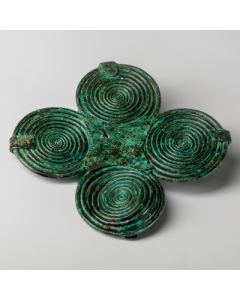 Italic quatrefoil fibula
Italic quatrefoil fibulaExtremely well preserved double spectacle brooch dating to the early Iron Age in Italy. 8th cent. BC. Acquired 1989 at Casa Serodine.
Price: on request Bowl of the Ica culture
Bowl of the Ica cultureAppealing pottery made by the precolumbian Ica culture and decorated with a linear pattern. Around 1000 AD.
Price: on request Celtic neck ring
Celtic neck ringOpen ring made of solid bronze. The torc is from Gaul or Central Europe and dates to the 4th or 3rd century BC.
Price: on request Egyptian Oxyrhynchus fish
Egyptian Oxyrhynchus fishBronze amulet of a worshipped species of Nile elephantfish. It was probably hung on a temple wall as an offering.
Price: on request Neo-Assyrian seal with mythological creature
Neo-Assyrian seal with mythological creatureThe octagonal stamp seal shows a hybrid creature and a priest. It originates from the Neo-Assyrian culture of the 8th to 7th cent. BC.
Price: on request Achaemenid stamp seal
Achaemenid stamp sealThis beautiful stamp seal is from the First Persian Empire of the Achaemenids or from parts under Greek control. 5th to 4th cent. BC.
Price: on request Two Mesopotamian mosaic cones
Two Mesopotamian mosaic conesThe pieces were part of a mosaic decoration of a Mesopotamian structure in the 4th Millenium BC. The temple architecture from Uruk is a particularly well known example of such a use.
Price: on request Krug aus dem heiligen Land
Krug aus dem heiligen LandKrug aus rötlicher Keramik mit seitlich angesetzem Henkel. Fund aus Palästina. Höhe 150 mm. Mittlere Bronzezeit II B-C, 1730 v. Chr. bis 1550 v. Chr.
Price: on request

